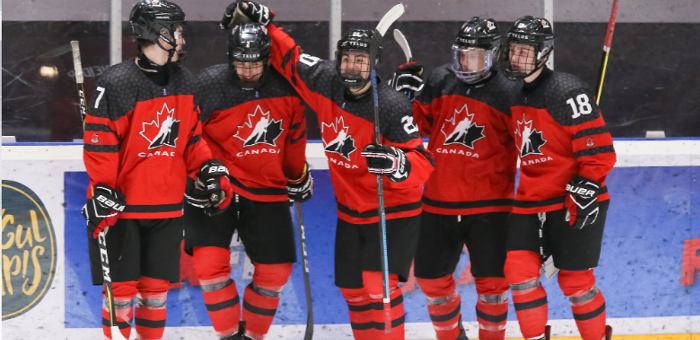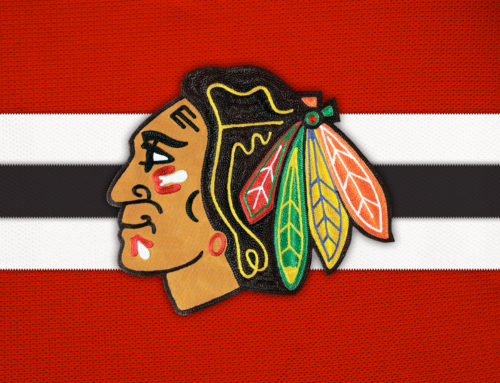Tournament Review: U18 Worlds – Part 1
Jokke Nevalainen
2019-04-29

The U18 Worlds are now over. Sweden won their first ever gold medal at the under-18 level, and doing it while hosting the tournament must feel extra special. Here’s the first part of my tournament review where I go through all the teams from Group A. The second part of my review is coming out tomorrow.
In case you missed the articles I posted during the tournament, here are links to them. I did a bunch of interviews while in Sweden, and I included most of them in those articles.
- First Update from the U18 Worlds (Apr 20)
- Second Update from the U18 Worlds (Apr 22)
- Third Update from the U18 Worlds (Apr 24)
Switzerland
Switzerland went to the relegation series after a loss to Finland in the final game of group play but they managed to win the series against Slovakia to stay at the top level next year. They didn’t have a very good team this year, and lacked star power in a big way.
Forwards Elvis Schläpfer (2019), Jannik Canova (2019) and Jérémy Zürcher (2019) led the team with six points in seven games. But the player who interested me the most was their top-line winger Simon Knak (2020) who captained the team as an underager and is eligible to return next year as well. Knak had one goal and four points in seven games. He showed good puck-skills and a good shot as well. He was used on both special teams, and was especially dangerous in three-on-three overtime. He has good size as well (6-0, 185).
On defense, Noah Delémont (2020) flashed some offensive talent and finished the tournament with three points in seven games. He’s another player who is eligible to return next year and be a difference-maker for Switzerland. He also carried an ‘A’ on his chest as an underager. He played on the top power play unit and was also used on the penalty kill. He’s a talented skater with skill but needs to improve his all-around game. He’s also an undersized player at 5-foot-9.
Finland
The 2018 World Champions had a very disappointing tournament with a seventh-place finish after only winning Switzerland in group play and then losing in a big way to USA in their quarterfinal match-up. There was something completely off with this team. Most of the blame has been placed on the head coach but top players have to share some of it as well.
Finland’s top player in the tournament was winger Patrik Puistola (2019) who had five goals in five games – although three of those goals came against Switzerland. Puistola played on the top line the entire time, and was used on both special teams. He showed some amazing one-on-one skills and strong two-way play. And obviously his finishing abilities were at full display as well. Puistola is a potential first-rounder this summer. He’s an average-sized (6-0, 174) winger with top-six upside.
The other top player for Finland was center Anton Lundell (2020) who scored two goals and four points in five games. He played big minutes and was used on both special teams. But as a returning player and someone who already won gold at the World Juniors, Lundell was expected to be a dominant player at this level and he wasn’t really able to reach that level. He was good but more was expected of him. He’s projected to be a top-10 pick in 2020.
Another returning player for Finland was winger Leevi Aaltonen (2019) who had a nice tournament as well, scoring one goal and five points in five games. Aaltonen was an alternate captain for the team – and Lundell was the other one. Aaltonen is projected to be drafted somewhere in the third or fourth round. He’s an undersized (5-9, 168) offensive winger who is capable of playing on both special teams – just like did in this tournament.
Wingers Tuukka Tieksola (2019), Veeti Miettinen (2020) and Kasper Simontaival (2020) had four points each. Tieksola is an underrated high-upside prospect for this summer whereas Miettinen and Simontaival are projected first-rounders in 2020. All three players got some power play time during the tournament. Tieksola is young for this draft class, and he’s physically very immature (5-10, 157). But he’s a great skater with amazing vision and great puck-skills. He needs lots of time before playing in the NHL and there’s obviously risk involved but his upside is very high.
Antti Saarela (2019) started the tournament as Finland’s number one center but after four periods, the coaching staff finally realized he’s not very good down the middle, so they moved him to wing. He’s been a center in junior but his game projects much better to the wing, even at this level. Saarela had one goal and three points in five games. He’s a fine complementary player but doesn’t really drive the offense. He was also used on the top power play unit but didn’t do a whole lot there.
Juuso Pärssinen (2019), Aku Räty (2019) and Aarne Intonen (2019) had two points each but were mostly depth players, and they were used on the penalty kill as well. Aatu Räty (2021) had just one assist but that’s a name you want to remember for the future. He’s a two-way center with great size (6-1, 170) and a great shot. A potential top-five pick in 2021.
On defense, Finland’s best player was definitely Ville Heinola (2019) who had a goal and four points in five games. He wasn’t really able to stand out as much as he should have based on his experience from the Liiga and the World Juniors. But he showed some great flashes and played big minutes. Heinola is projected to go in the top-20 this summer. Similar to Tieksola, Heinola is also physically immature (5-11, 181) and needs patience. He doesn’t have great speed or a heavy shot but he has a great head on his shoulders and a good pair of hands.
The biggest disappointment for me was the performance of Mikko Kokkonen (2019) who played on the top pair and even got some power play time late in the tournament but was held to just one point in five games. Kokkonen is a potential first-rounder this summer after a strong season in the Liiga but a performance like this doesn’t help his stock one bit. Compared to Heinola, Kokkonen is physically much more mature (5-11, 198) which would allow him to play in the NHL sooner if he could improve his game enough by that time. But there are legitimate concerns about his upside.
Antti Tuomisto (2019) was having a pretty good tournament until a kneeing incident got him ejected and eventually suspended during the fourth game. At that point, Tuomisto had recorded two assists. He played on the second pair and on the second power play unit as the only defenseman. At 6-foot-3, Tuomisto has great size for a defenseman. He has a heavy shot, and he shoots from the right side which is always valuable. He’s an offensive defenseman who needs to work on his decision-making and defensive play. But there’s a lot of raw potential, and he should hear his name called in the second round this summer. He’s going to the NCAA route.
Even though he didn’t get any points, Santeri Hatakka (2019) had a strong tournament. He’s an average-sized (6-0, 174), defense-minded defenseman but is capable of doing some things offensively as well. He’s a potential late-round pick. Team captain Iivari Räsänen (2019) had one assist, while Topi Niemelä (2020) had a goal and Kalle Loponen (2019) had a goal and an assist. Loponen was Finland’s seventh defenseman but got more time after Tuomisto wasn’t allowed to play anymore.
Goalie Roope Taponen (2019) wasn’t really able to help his draft stock in this tournament. He’s a potential late-round pick but it remains to be seen if he gets drafted or not. He doesn’t have great size (6-0, 165), and hasn’t had the type of season that would get him noticed all that much.
Czech Republic
Winger Filip Koffer (2019) led the team in goals and points with four goals and six points in five games. Another strong performer was center Marcel Barinka (2019) who had two goals and five points.
The guy I was expecting more from was winger Michal Teplý (2019) who is known as a great goal-scorer but finished the tournament with no goals and three assists. He was taken off the power play at some point for whatever reason but he had enough opportunities to score, just didn’t have a very good tournament.
Winger Jan Mysak (2020) started the tournament as the 13th forward but was quickly promoted to the second line, and he started to get power play time quickly after that. Mysak finished the tournament with three assists and played really well. He’s eligible to return next year, and should be the top player for the Czechs. He’s a projected top-20 pick in 2020.
Defenseman Martin Hugo Has (2019) had a solid tournament, scoring one goal and two points in five games. He’s not the most talented offensive player but plays a really good two-way game, has a big shot, and has great size at 6-foot-4. He’s staying in Finland for next season, and after two years in the junior level, he should see plenty of games at the pro level.
Lukas Parik (2019) ended up being the number one goalie for the Czechs after a weak start to the tournament by Jan Bednar (2020). Parik is a highly-ranked goalie with great size at 6-foot-4. His .924 save percentage was third-best in the tournament.
Belarus
Belarus surprised a lot of people in this tournament, finishing ahead of Czech Republic and Finland in group play, and because all three teams lost their quarterfinal match-up, Belarus finished the tournament as the fifth-ranked team.
Winger Yevgeni Oxentyuk (2019) led the team in goals and points with three goals and six points in five games. He’s a small (5-7, 154), offensive winger who lacks defensive awareness to a certain degree. He’s also not a good skater which is worrisome for a small guy like him. He might get drafted in the final rounds because of this tournament and his performance in the top league in Belarus but I would like to see what he does next year before making that commitment.
Defenseman Vladislav Kolyachonok (2019) captained the team and also led the team in shots with 27. He finished the tournament with one goal and five points in five games – only Oxentyuk had more points than him. Kolyachonok is a two-way defenseman with good size (6-2, 181). His counting stats in the OHL may not impress you but he played for an awful Flint Firebirds team. He’s projected to be drafted somewhere in the second round this summer.
Canada
Canada had a disappointing fourth-place finish but many of their players shone brightly. Top-line center and team captain Peyton Krebs (2019) led the team in goals and points with six goals and ten points in seven games. Krebs wasn’t as flashy as some of the other players on the team but he had a great tournament playing a great all-around game. He was used on both special teams and looked dangerous in both situations. Krebs isn’t overly big (5-11, 181) but he plays a strong game. He’s projected to go in the top-10 this summer.
Alex Newhook (2019) had also ten points but only had five goals. Newhook played left wing in the tournament but is a natural center. A lot of people have struggled to scout him this season because he’s played in the BCHL and hasn’t played in any major tournaments. But here, he showed why he’s a projected top-15 pick who should get some consideration in the top-10. He was the most noticeable player on his team, even more so than Krebs. He wasn’t used on the penalty kill but was responsible for running their top power play from the half-wall. He isn’t big either (5-11, 190) but he has amazing speed which makes him a very dangerous offensive player.
The third wheel on that top line was Dylan Cozens (2019) who had four goals and nine points. He’s a natural center but played right wing in the tournament. At 6-foot-3, he’s significantly bigger than his linemates. Cozens was the least noticeable member of their monster line but it’s not like he played badly. He was used on both special teams, including on the top power play, and he carried an ‘A’ on his chest. He’s ranked higher than both Krebs and Newhook but it remains to be seen if that’s the actual order they go in the summer.
Other forwards with very impressive performance in the tournament were Jamieson Rees (2019), who had two goals and eight points, and Brayden Tracey (2019) and Connor Zary (2020) who had four goals and seven points each. Rees and Tracey are projected second-rounders while Zary misses the draft eligibility cut-off by just ten days. Tracey was used on the top power play.
Also worth noting is the performance of Philip Tomasino (2019) who flashed some great skill while scoring one goal and five points in six games. He was responsible for running their second power play unit, and he looked great doing so. He has good size (6-0, 181), and he’s young for his draft class. He’s projected to go late in the first round or early in the second.
Winger Nathan Légaré (2019) had four goals in seven games, showing that great shot he has. Because of his shot, he was sometimes used on the top power play for one-timers. He also killed penalties and wore an ‘A’ on his chest. He’s physically very mature already (6-0, 201), and is projected to be drafted somewhere in the second round.
On defense, Canada’s top player was Thomas Harley (2019) who scored a goal and four points in seven games. He played on the top pair and also on their top power play unit. He did make some noticeable mistakes but also made many more great plays to cover for them. He has great size (6-3, 187), and he’s projected to go in the first round this summer.
Defenseman Braden Schneider (2020) had a good tournament as well, scoring two goals and three points in seven games. He misses the draft eligibility cut-off by just five days, making him one of the oldest players for the 2020 draft.
In goal, Canada got good performances from both Taylor Gauthier (2019) and Nolan Maier (2019). Gauthier is the bigger goalie of the two, and he’s also ranked higher than Maier. Gauthier also got the start in their semi-final game against Sweden. But Maier got the start in the bronze medal game, and he had the better save percentage in this tournament: .926 vs .914.
*
And that’s all for now, thanks for reading. Feel free to add comments below. Remember to follow me on Twitter @JokkeNevalainen.
Main picture courtesy of IIHF.com





